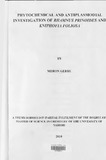| dc.description.abstract | The dried and ground whole root of Rhamnus prinoides (Rhamnaceae) were exhaustively
extracted using dichloromethane/methanol (1: 1) by cold percolation. The crude extract was
subjected to chromatographic separations on oxalic acid impregnated silica gel, Sephadex LH-20
and preparative TLC, which resulted in the isolation of six compounds. The structures of the
isolated compounds were determined using spectroscopic methods including UV, 'n and J3C
NMR, COSY, NOESY, HMBC and HMQC and where necessary, by comparison with authentic
samples. These were three anthraquinones [chrysophanol (1), physcion (2) and emodin (3)], a
flavonol [rhamnazin (4)] and two naphthalenic derivatives [~-sorigenin (5) and geshoidin (6)].
The rhizomes of Kniphofia foliosa (Asphodelaceae) were dried, ground and extracted using
dichloromethane/methanol (1: 1) by cold percolation. Chromatographic separation led to the
isolation of three monomeric anthraquinones [chrysophanol (1), islandicin (7) and laccaic acid D
(8)], a dimeric anthraquinone [chryslandicin (9)], a phenyl anthraquinone [knipholone (10)], two
dimeric phenylanthraquinones [joziknipholone A (11) and joziknipholone B (12)], a tetrameric
phenylanthrone [Jozi-joziknipholone anthrone (13)], and a benzoic acid derivative [3,4dihydroxybenzoic
acid (14)]. The structures of these compounds were also determined using
spectroscopic techniques.
The tetrameric phenyl anthrone Jozi-joziknipholone anthrone (13) isolated from Kniphofiafoliosa
in this study is the first and the only example of a tetrameric phenylantraquinone. Furthermore,
this is only the second report on the occurrence of the two dimeric phenylanthraquinones
[joziknipholone A (11) and joziknipholone B (12)] in nature. Laccaic acid D (8) is reported here
for the first time from the family Asphodelaceae.
The in-vitro antiplasmodial activities of the isolated compounds were performed against the
chloroquine-sensitive (D6) and chloroquine-resistant (W2) strains of Plasmodium falciparum.
The naphthalenic derivative Geshoidin (6) from Rhamnus prinoides showed an ICso value of 4.0
± 0.9 11M and 0.4 ± 0.2 11M against the chloroquine sensitive (D6) and chloroquine resistant
(W2) strains of Plasmodium falciparum. The dimeric anthraquinone 9 [ICso = 6.5 11M (W2)], the
phenylanthraquinone 10 [ICso = 10.4 ± 2.4 11M (W2), 23.3 ± 0.1 11M (D6)], the two dimeric
phenylanthraquinones 11 [ICso = 0.4 ± 0.01 11M (W2), 0.2 11M (K1)], 12 [ICso = 3.3 ± 0.91 11M
(W2), 0.3 11M (K2)] and the tetrameric phenylanthrone 13 [ICso = 0.3 !J.M (K1)] showed good to
potent antiplasmodial activities. The antimicrobial activities of the isolated compounds were also
tested, but no significant activity was observed for any of the compounds tes | en |

